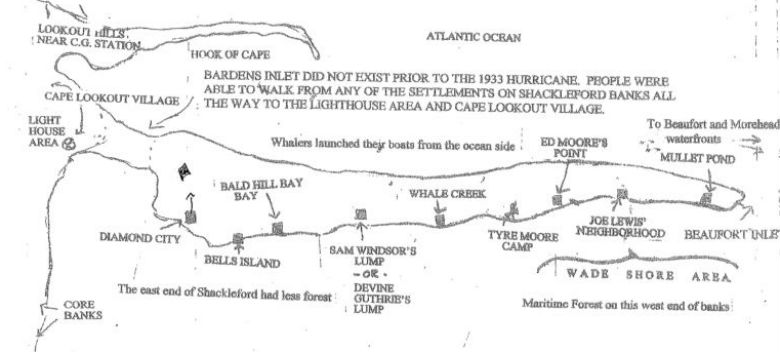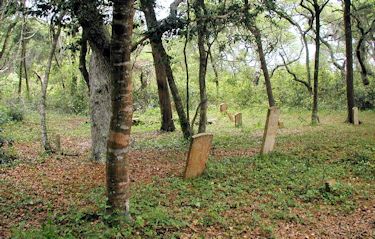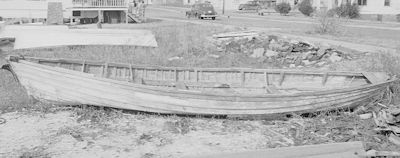A banner at the Core Sound Waterfowl Museum & Heritage Center welcomes descendants of the hardy fishing families who once lived on what is now Shackleford Banks in the Cape Lookout National Seashore.
First of two parts
 A Guthrie family memorial at the Diamond City Reunion on Harkers Island. |
 Devine Guthrie was a boat builder, whaler and preacher. This is one of the few surviving photos from Diamond City and Shackleford Banks. Photos: Core Sound Waterfowl Museum & Heritage Center. Devine Guthrie was a boat builder, whaler and preacher. This is one of the few surviving photos from Diamond City and Shackleford Banks. Photos: Core Sound Waterfowl Museum & Heritage Center. |
HARKERS ISLAND – It took more than a bit of courage to fire this old whale gun. The steel, rifled barrel is encased in sturdy hardwood that smells of linseed oil and has taken on a deep, reddish-brown hue after more than a century of loving care. Trimmed with brass plate, the gun is a little more than three feet long but weighs almost 17 pounds. Capt. Seef Willis must have held his breath and muttered a prayer when he hoisted it to his shoulder and steadied himself in the heaving pilot boat before pulling the trigger to help bring in the most famous and perhaps the most vicious whale ever caught along the N.C. coast.
Supporter Spotlight
“Because she packed a kick,” Thurman Douglas Willis, the captain’s great-great grandson, said of the old gun. “She could knock you overboard.”
Willis was among the hundreds of people who gathered on Harkers Island in Carteret County last month to take part in a special reunion. Most were descended from the hardy fishing families who once lived in scattered, small settlements on what is now uninhabited Shackleford Banks in Cape Lookout National Seashore. Ca’e Bankers, they called themselves, after conveniently removing the “p” from “cape.”
From Cape Hills near the lighthouse, across The Drain to Diamond City and Bald Hill Bay, to Sam Windsor’s Lump and all way to Wade Shore at Beaufort Inlet, the Bankers lived in isolation and wrestled meager livings from the sea.
They had been doing it for more than a century before it all came to a sad end when the worst hurricane anyone on the Banks could remember slammed ashore 115 years ago. Houses were left in shambles, boats lay splintered, wells were flooded and the soil too contaminated with salt to grow anything for a long while.
So those who remained reluctantly left the island. Family by family, they loaded their possessions and even their homes onto small boats and sailed the two miles across Back Bay to Harkers Island. A few ended up in nearby Marshallberg. Those at the western end of the Banks crossed the Beaufort Bar to Gillikin, now Salter Path, on Bogue Banks or sailed farther west in Carteret County to Broad Creek. Some of the refugees went to the bustling port town of Morehead City where they set down stakes and started life anew in a neighborhood they called the Promise Land.
Supporter Spotlight
By 1902 or so, the Ca’e Bankers were gone. All evidence that they had even been there soon disappeared as well. Waves and wind have a way of erasing history if given enough time. All that’s left now are the artifacts the Bankers left behind and the stories told by their descendants.
Every five years or so, they come together at the Core Sound Waterfowl Museum & Heritage Center to tell those stories, to sing the old hymns, to lay a wreath at the old cemetery on Shackleford and to display the old pictures and letters and other pieces of that old life — great-great grandmother’s shawl, great-aunt’s flowered quilt, Capt. Seef’s whale gun.
“We need to preserve this heritage because this the last generation that will care about it,” said Rodney Kemp, a noted local historian and himself a resident of the Promise Land. “That’s what makes these gatherings so important.”

Whaling on the Banks
Nor’easters had been plentiful during the winter of 1874. The mullet fishing, as a result, had been a bust. The fishermen of the Banks relied on jumping mullet in the fall and winter. Female mullet were especially prized for their roe, which fetched a pretty premium over in Beaufort. Banks’ fishermen also went after croaker, spot, flounder, trout and even porpoises at various times of the year.
Late winter and early spring, though, was money time. A good whaling season could make a man forget about winter blows and empty nets. The oil boiled from the fat and blubber of right and sperm whales was valuable as lamp oil and lubricants. The baleen that right whales use to strain water was refashioned into women’s corsets, umbrella tips and such. The whalers collected a very high quality wax called spermaceti from the heads of sperm whales that was used in expensive candles. Ambergris from the sperm whales’ digestive systems was somehow turned into a fragrance and fixative in perfumes. Three or four of the giants, then, were far more valuable than many boatloads of mullet.
Yankee fishermen from New England started hunting whales off Cape Lookout in the 1720s, dropping anchor in the protected waters behind the cape’s hook and intercepting northbound whales on their spring migrations. It was sort of hit and miss, though, and not very profitable, but it got the few people then living on the Banks to thinking. They, too, started whaling, launching small boats from the beach when a whale was spotted and then hauling the animal back for processing.
 The old cemetery on Shackleford Banks. Photo: Frank Tursi |
The captain of an English ship, making a detailed survey of the Cape Lookout area in 1764, noted several buildings just west of the cape that he identified on his map as “Whalers Hutts.” Within 100 years, the fishing and whaling would attract a fairly sizable population. Estimates vary. Some think that as many as 2,000 people lived on the island during its heyday in the mid-1870s. Others put the number at half that. The U.S. census takers in 1850 counted 302 people on the Banks, but they probably missed as many.
The Ca’e Bankers lived in a string of small settlements that started in the high dunes around the lighthouse and stretched west to Beaufort Inlet. A shallow swash that the Bankers called The Drain separated the lighthouse area from the rest of the island, but residents could walk across it at about any tide. A hurricane in 1933 opened what’s now Barden’s Inlet at The Drain and made Shackleford a separate island.
None of the settlements was very large, Kemp explained, maybe a dozen or so related people living in a collection of houses. “They were family groupings, really,” he said.
The groupings took on the names of the families that lived in them – Ed Moore’s Point, Kib Guthrie’s Lump, Tyre Moore’s Camp, Sam Windsor’s Lump, Joe Lewis’ Neighborhood.
The exception was the sprawling collection of buildings that spread out from Yellow Hill, a 40-foot-high sand dune just west of The Drain. The official U.S. Coast Survey of 1853 identified the settlement as “Lookout Hills.” Thirty or so years later it would take the name of the familiar pattern of the nearby lighthouse, Diamond City.
As many as 500 people may have lived there by the mid-1800s. Most were fishermen, but there was also a smattering of carpenters and shopkeepers and at least two mid-wives. The place boasted three general stores and a schoolhouse, where teachers from the mainland came each summer to give the island’s children a couple of months of instruction. The building also did double duty as a church, where itinerant preachers occasionally stopped. The Pentecostals always drew large crowds at their camp meetings “under the cedars.”
Smoke on the Beach

This picture of the last Shackleford Banks whale boat was taken in the 1940s. The boat was last used by John E. Lewis. Photo: N.C. Museum of Natural Sciences |
The fishermen in the three pilot boats that gathered in the bight at first light on May 4, 1874, probably didn’t talk much about Pentecostals or teaching young’uns. The tobacco embers in their pipes glowed in the pre-dawn as the men lamented the winter’s poor fishing and expressed hope that the spring would be better.
Josephus Willis was among them. At 46, Capt. Seef, as he was known to all, was already one of the Banks’ most respected men. Born on Shackleford, he had been a private in the Confederate Army and was at Fort Macon when it fell to the Yankees in 1862. He spent two days at a prison camp in New Bern before being paroled. He came home to stay.
Five of his eight sons were in the boat with him that morning. Old Capt. Seef must have had a bit of a showman in him because he had his boys paint the oars bright red. They called themselves the Red Oar Crew.
The boats were about to head out for the start of the day’s fishing, when one of Capt. Seef’s sons pointed to the sky behind them. “Look,” he yelled, “smoke.”
Capt. Absalom Guthrie had shore watch duty that morning. His job was to scan the seas from the top of a high dune and look for whales. He was to send up a smoke signal if he spotted any.
The men in the boats stowed the gear for small fish and got the harpoons and lances ready before rowing out to sea. Other whalers had seen the signal and were dragging their boats into the water.
Among them was Sam Windsor, the only black man living on the Banks. He was known for his level head and melodious voice. He brought Bankers nearly to tears when he raised it in supplication to sing his favorite hymn, “How Tedious and Tasteless the Hours.”
“Oh, drive these dark clouds from my sky;
Thy soul-cheering presence restore;
Or take me unto Thee on high,
Where winter and clouds are not more.”
Capt. Seef wasn’t thinking about cheering souls and Sam’s singing, as his boys rowed hard to meet the whale. He was too busy loading the gun.
Tuesday: The Promise Land and the Mayflower whale








